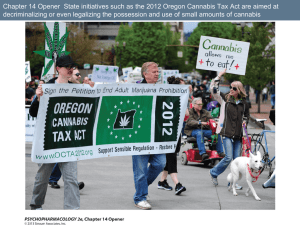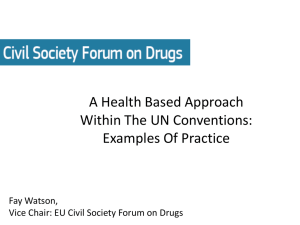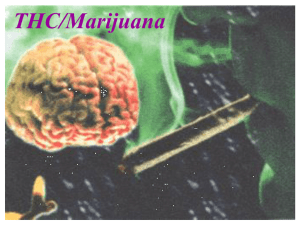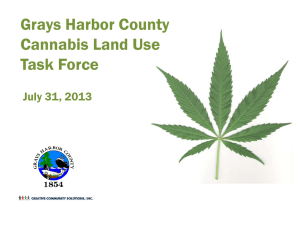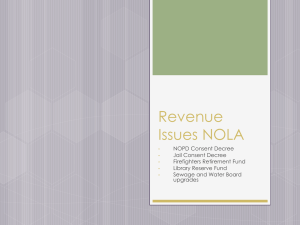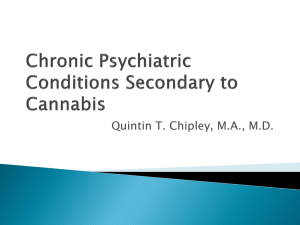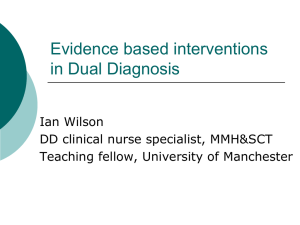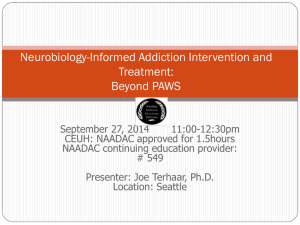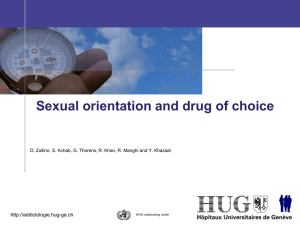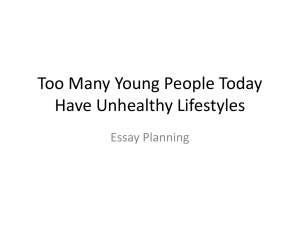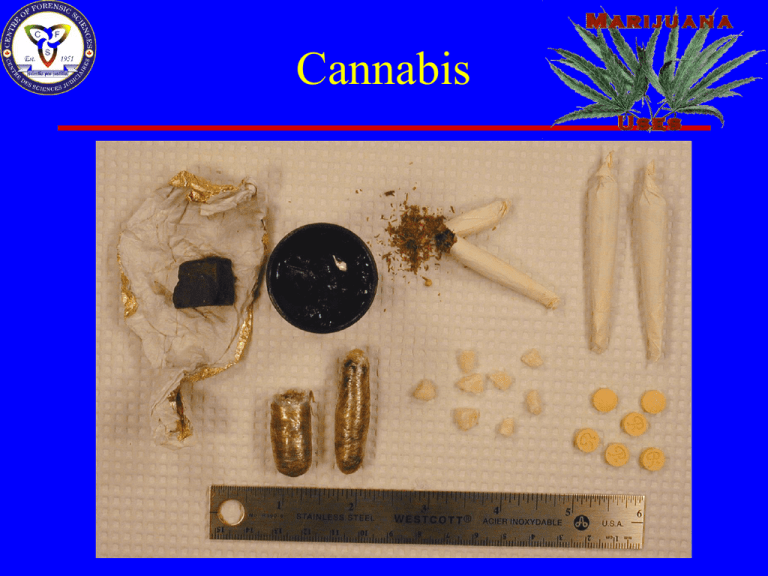
Cannabis
Cannabis
History of use
• Material from the Cannabis plants
– Cannabis sativa and Cannabis indica
• Known to have been cultivated for approx.
12,000 years (beginning in China)
• Plant stems - rope and linen
• Flowers and seeds & especially a resin on
and within them contain the psychoactive
chemicals termed Cannabinoids
Cannabis
Origins & History of use
• Psychoactive properties were first recorded
about 2800 BC in China and 2000 BC in
India
• Early uses included rheumatic pains,
constipation, malaria, ‘absentmindedness’,
menstral cramps, and for its anxiolytic and
euphoric properties
Cannabis
Origins & History of use
• Claims for medicinal and psychiatric uses
expanded in the 1800’s and 1900’s as for all
drugs
• Hash (the name for the resin) comes from
the arabic word hashsha shim (meaning
hash eaters- it also spawned the word
assasin)
Cannabis
Origins & History of use
• Marijuana (the name for the dried and
crushed flowers) comes from the spanish
maraguanaquo (meaning an inebriant plant)
• Cannabis became an illegal substance in
North America in the 1920’s
• Revival in marijuana interest occurred in
the 60’s
Cannabis
Origins & History of use
• Marijuana was first used by the Beatles
while filming “Hard Day’s Night” (see the
snow scene) and flourished along with other
“mind expanding drugs (psychedelics) such
as LSD and PCP
Cannabis
Current Use & Prevalence
• Most widely used illicit drug in the world
• Primary users are teenagers and young
adults with use dropping with age (and finer
appreciation of wines, single malts and
Guiness!)
• North American use was highest in the 70’s
but use has ‘levelled off
Cannabis
Current Use & Prevalence
From the Toronto Drug Survey
Cannabis
Current Use & Prevalence
• Use in other countries follows different
courses (e.g. use in the Netherlands is
increasing in the older population)
• Medicinal use is expanding (separate
section)
• Revival of the use of hemp & hemp fibre in
producing rope, linen, beer etc (all without
psychoactive chemicals).
Cannabis
Pharmacology
Primary Cannabinoids from Cannabis are:
• Cannabinol (CBN), Cannabidiol (CBD) and
Tetrahydrocannabinol (THC)
• THC (D-9-THC ) is the only one with
significant psychoactive properties
• CBN - 1/10 th activity of THC; CBD - none
Cannabis
Pharmacology & Toxicology
• Primary routes of administration are:
oral or smoking
• Smoked marijuana or inhaled hash (much
more potent) provides the highest delivery
• From a theoretical 69% availability
(machine pyrolysis of 1 joint in one puff)
actual availability ranges from 10%
(infrequent) to 25% (heavy users)
Cannabis
Pharmacology
• Typical joint weighs 0.5 - 1 gram and
contains 20 + mg of THC
• Therefore it delivers a maximum of
0.2 - 5 mg of THC
Cannabis
Pharmacology
• Cannabinoids are highly lipophilic and
lipoprotein bound
• Vd = 10 L/Kg
• Blood concentrations are therefore not
directly related to drug effect
• Release from lipid stores and enterohepatic
recirculation account for retention of THC
and terminal half life > 4 days in frequent
users.
Cannabis
Pharmacology
Huestis et al., 1992, J. Anal. Toxicol., 16:276-290
• Six Volunteers smoked 1 “joint” with 15.8 mg
THC over an 11 minute period
• Plasma THC peaked at 50 - 129 ng/mL at
9 minutes (i.e. before they had finished)
• One hour later THC had fallen to 3-20 ng/mL
• Levels of 1-2 ng/mL in plasma can persist from
hours to days depending on the frequency of use.
Cannabis
Triphasic Pharmacokinetics
A
30
35
40
45
50
55
Pharmacology
15
20
25
B
5
10
C
0.5
1
2
3
4
5
Time in hrs
6
7
8
1 day
1.5 days
2 days
2.5 days
Cannabis
Pharmacology
• Urine THC can be detected for days after
use
• In one instance a frequent marijuana user
had THC positive urine for 42 days!
Cannabis
Pharmacology
• Passive Inhalation (“Snowboarding Effect”)
• Requires very high concentrations of smoke
in a small enclosed area (sometimes
requiring goggles)
• Most of these studies identified positive
urine tests only (one study reported blood
THC 1-6 ng/mL immediately after
exposure)
Cannabis
Onset & duration of effects
• Physical and psychological effects
commence within minutes of finishing a
joint
• Psychological effects can persist from 4 to 8
hours depending upon route of
administration (oral, slower onset, longer
duration)
• Effects do not depend on blood
concentration but partially on dose
Cannabis
Specific psychological effects
• Effects are dose -dependant and route
dependant.
• Effects can generally be felt within 15
minutes and peak effects occur within 30 to
60 minutes post-smoking and last 2-4 hours
• Spectrum of effects precludes classification
as a stimulant, sedative or hallucinogen.
Cannabis
Specific psychological effects
• Effects of lower doses include: euphoria,
relaxation, wide range from exhilaration to
introspection; distortion of time and some
visual hallucinations; memory distortions,
especially diminished short-term memory
and hunger
• Response to higher doses: anxiety, tension,
anger, confusion, hallucinations, paranoia
and panic attacks.
Cannabis
Specific psychological effects
• THC can unmask manic depressive or
schizophrenic patients as will other mood
altering, mild hallucinogenic drugs such as
MDMA
Cannabis
Specific psychological effects
• Laboratory tests reveal memory deficits
(and other impairment described later)
• No objective test of impairment
• Therefore a relative scale of ‘high’ is used
e.g. relative to the ‘most stoned you’ve ever
been’ is usually employed
• This scale can be used to account for
tolerance in frequent vs non-frequent users.
Cannabis
Specific psychological effects
• Wide spectrum of effects fit (to some
degree) observed THC interaction with
opioid or benzodiazepine receptors.
• Also interaction with organelles and
demonstrated ability to inhibit
macromolecular metabolism, effect enzyme
systems, hormone secretion and
neurotransmitters
Cannabis
Specific psychological effects
• Specific Cannabinoid receptors (Central:
CB1 & Peripheral: CB2) have been
identified in the brain and PNS.
• Endogenous ligands e.g. Anandamide and
2-arachidonyl glycerol have been identified.
• Recent research shows anadamide may be
involved in the abolition of ‘extraneous’
short term memories.
Cannabis
Specific physiological effects
• Tachycardia (Increased Heart rate)
• Red eye (vasodilation of the conjuctiva) and
peripheral vasodilation.
• Increased Blood pressure
• Diminished fine motor control (hand
steadiness)
Cannabis
Toxicology
• Very wide ‘therapeutic index’
• No known direct deaths
• Fatal dose is unknown, but implied from
animal studies may be 4000 to 40000 times
the highest recreational dose.
• Implied association with deaths due to
underlying heart conditions especially
arrythmias/ heart attacks; not confirmed
Cannabis
Clinical Uses
• Synthetic THC Marinol®, dronabinol
• Bioavailability is 10-20% of IV (high first
pass effect).
• t 1/2 ~ 60 hrs
• prescribed for severe nausea & vomiting
associated with chemotherapy
• Side effects: sedation, mode altered (laughing,
elation), confusion...
Cannabis
Clinical Uses
“Medical Marijuana”
• Low bioavailability of dronabinol have lead
to the ‘experimental’ use of smoked MJ in
clinical research
• MJ use in glaucoma (reduction in
hypertension) has been established
• Appetite enhancement is also established
and useful for AIDS and cancer patients
Cannabis
Clinical Uses
“Medical Marijuana”
• Reported to have antispasmodic and pain
reduction properties in the treatment of
Multiple Sclerosis (antispasmodic &
analgesic; mostly subjective evidence to
date).
• Other studies are focusing on analgesis,
anti-inflammatory, antitumor and antiepileptic possibilities
Cannabis
Clinical Uses
“Medical Marijuana”
• Very few clinical studies of actual benefits
of cannabis in treating medical conditions
• Most of the information is anecdotal and
‘popular’ (i.e. produced by activists outside
of the oppressive establishment and
therefore true by definition).
Cannabis
Clinical Uses
“Medical Marijuana”
• Canada is was the only country which
allows Medical use (medical exemption by
‘prescription’; physicians are allowed to
prescribe drugs in whatever dose and for
whatever reason they deem fit/e.g.
pediatrics and & psychiatry)
Cannabis
Clinical Uses
“Medical Marijuana”
• However, Health Canada is still
investigating claims of the effectiveness of
cannabis (one stated use of the MJ crop
being grown for Health Canada).
Cannabis
Clinical Uses
“Medical Marijuana”
• Thus Medical MJ users live in a ‘Catch 22’
situation… they can possess MJ, Health
Canada grows its, but will not provide it
yet… they must obtain seeds etc illegally,
but once in their possession, it’s legal.
Cannabis
Toxicology
Results of consuming a psychoactive agent
with hallucinogenic and sedative properties
1) Sexual assault
2) Driving
Cannabis
Toxicology:DFSA
• Cannabis is the second-most common drug
in sexual assaults, next to alcohol
• This is probably due more to the wide-spread
use of the drug, rather than an attempt to
‘incapacitate’ another individual
• Yet, MJ sedating & memory reducing
effects will enhance the effects of CNS
depressants
Cannabis
Toxicology: Impaired by THC
• THC has been implicated with other drugs
and alcohol in contributing to vehicular
accidents and fatalities for many years from
epidemiological data
• One major problem is the concomittant use
of alcohol and marijuana.
• Impediment to determining the actual
contribution of THC to impairment
Cannabis
Toxicology: Impaired by THC
• Laboratory studies
• THC impairs: divided attention, short term
memory, concentrated attention, emergency
situation reaction times, speed regulation.
• Appears to improve some aspects relative to
alcohol: drivers appear more cautious,
willing to take less risks, give more
headway
Cannabis
Toxicology: Impaired by THC
• Headway abolished with higher doses
• ‘Caution’ (timidity) may prove dangerous in
heavy traffic or in emergency situations
• Suggestion that users can compensate
(similar to alcohol at 10-20 mg% in adults)
• Visual/temporal distortions, memory
deficits and inability to remain focused
however, can’t be fully compensated
Cannabis
Toxicology: Impaired by THC
• Studies also may use unrealistic amounts of
cannabis, based on perceived high (e.g. drug highs
depend upon social interaction, setting etc)
• One study, Robbe, (1994, Inst Hum
Psychopharmacol) used significantly higher doses,
but would not test impairment at the higher doses
on a city street, due to safety concerns despite
claiming that MJ had a significant, but not
dramatic impairing effect
Cannabis
Toxicology: Impaired by THC
• Closed/Open course Driving Studies show
impairment of:
• road tracking (standard deviation of lateral
position or ability to stay within a lane)
• ‘cautious’ headway at low doses; lost at
higher (relevant) doses.
• Vigilance also appears to be reduced
• Few studies to date
Cannabis
Toxicology: Impaired by THC
• Study by Ramaekers et al
• Measured the effects of THC & alcohol
• Found significant impairing effects at blood
alcohol concentrations as low as 35 mg%
(equal as little as 1 beer in women and 2
beers in men)

